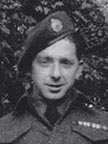
Our veterans
Ralph Ellis
Born May 20th, 1923 to Albert and Jean Ellis of Montreal, Ralph enlisted at age 18. He spent the first 10 days at the Jacques Cartier Barracks in Montreal before being sent to Huntingdon, QC, for his basic training, then to Petawawa for advanced training. The order came to travel to Halifax, N.S., and embark on the HMCS Duchess of York bound for Europe. It was a long journey, but safe enough, since the convoy consisted of over 100 ships and was well protected.
Ralph was a sapper in the Royal Canadian Engineers, whose work included road construction and maintenance, reconnaissance and construction of Bailey bridges. They also preceded the infantry and tanks in order to lift mines and clear the roads.
Soon after their arrival in Liverpool, England, they boarded the HMS John Erickson bound for Naples, Italy. After passing Gibraltar, German planes attacked and sank three ships: two Dutch vessels and one hospital ship. Ralph’s division of Royal Canadian Engineers bivouacked in a field between Naples and Caserta waiting to be sent to build Bailey bridges at various places: Atessa, in the mountains on the Sangro river, also over the Arraella and Rapido rivers, and finally along the Hitler Line. “This line across Italy ran from Terracina on the Tyrrhenian coast to Pontecorvo, Aquino and Piedimonte . . . north of Cassino. Towering over the town was Monte Cassino with its famous monastery.”
During the month of May and especially from the 19th to the 23rd, the fighting was fierce and Allied casualties were heavy. The Canadians succeeded in breaking through the Hitler Line and the Division kept pushing north to the Gothic Line, from the Tyrrhenian Sea through Pisa and Florence, to Pesaro on the Adriatic.
Despite heavy bombing of bridges by the Luftwaffe, the bridge at Ponte Vecchio was spared because of its historic value, as were Rome and the Vatican.
One night, Major R. B. Cameron detailed Ellis to deliver a message asking for protection in the building of a bridge. He told Ralph to remember the password for the night: TOP HAT. Mr. Ellis and his companion, Andy Burroughs from Smith Falls, got lost around 1:00 a.m. They entered a stationery store and, on their way out, were met by military police demanding the password and asked if they had seen any Germans. Upon Mr. Ellis’ negative answer, the Allies learned that the Germans had already left a town the Allies wanted to capture!
Another time, Ralph lost his way and had to ask directions from an elderly Italian man. Ellis could barely speak Italian and the man was not fluent in English.
“Are you Catholic?” asked the old man.
“No. Why?”
“Still, you’ll recognize the name of this town. Come with me.”
Ralph protested that he was in a rush and didn’t have time.
“Son, the war can wait.” said the old man, who then led him to the Church of St. Francis of Assisi.
The detour was worth it, and Ralph never forgot this saint!
In February 1945, Mr. Ellis and his Division left Leghorn, Italy for Marseilles, France, in a landing craft. Since they were near Genoa, they served as bait: the goal was to make the U-boats come out of hiding and divert their attention from Allied tanks and equipment making their way from Italy to France. The fact that the Canadians were leaving Italy had to be kept secret. The two divisions made their way from Marseilles to the outskirts of Paris, then to Ypres, Belgium and then on to Arnhem, Holland, where the fighting was still intense.
Later, as the Allies advanced, Ralph Ellis was transferred to Division Headquarters in Apeldoorn, Holland. It was a promotion of sorts, since he was now chauffeuring a Brigadier, had a flag on his jeep and partook of better food and accommodations. His activities brought him to Groennengen, Holland, where his life became complicated.
As the war ended and Allied soldiers were celebrating victory, Ralph began to feel ill with headaches, a sore throat and fever. He visited a hospital’s outpatient clinic and was promptly admitted with a highly contagious case of diphtheria. All his personal effects, ID papers and souvenirs of places he had visited were back at his barracks and he had no chance to retrieve them. Sent to a convent turned hospital in Oldenburg, Germany, and from there to an airport in Belgium, he would spend the next three weeks in a British hospital.
When the time came for him to be shipped back to Britain, he was put on a train with German war prisoners by accident. Thanks to a Canadian nurse — who recognized him — he was finally put on the right train to Ostende, where he took a boat to Dover, England. Penicillin, a new drug at the time, was administered and he was sent home to Canada on the HMCS Queen Mary in October 1945.
